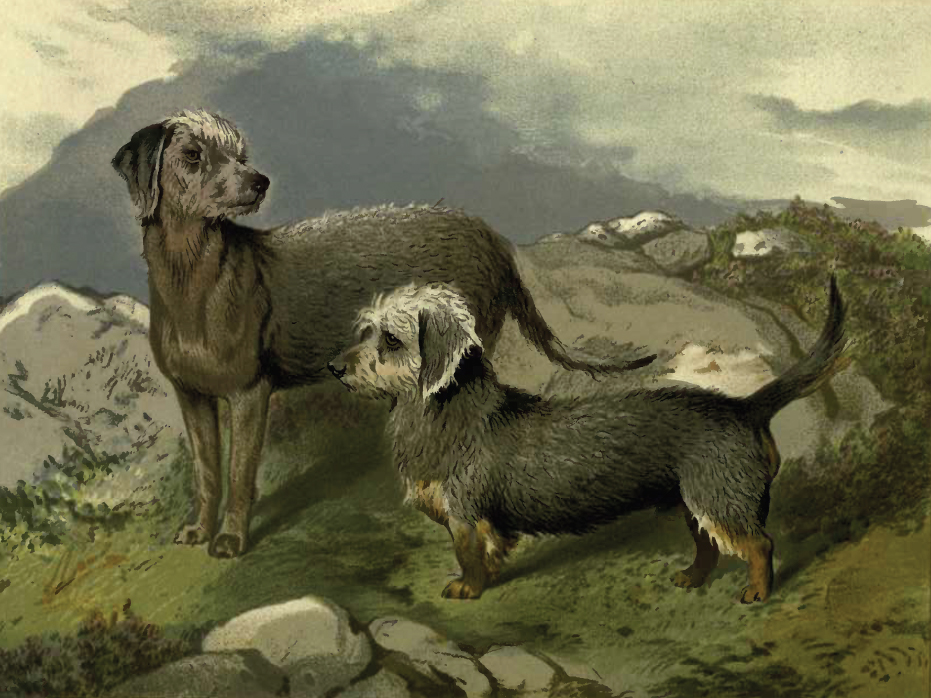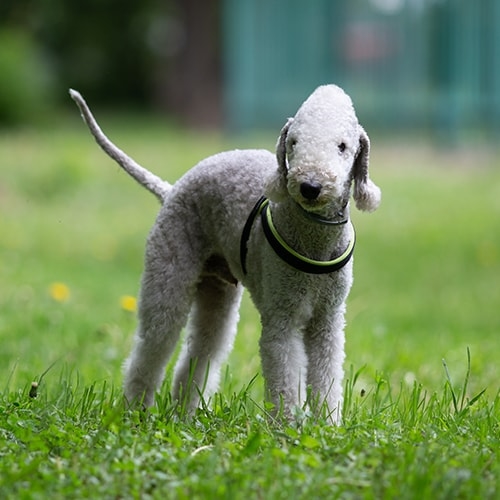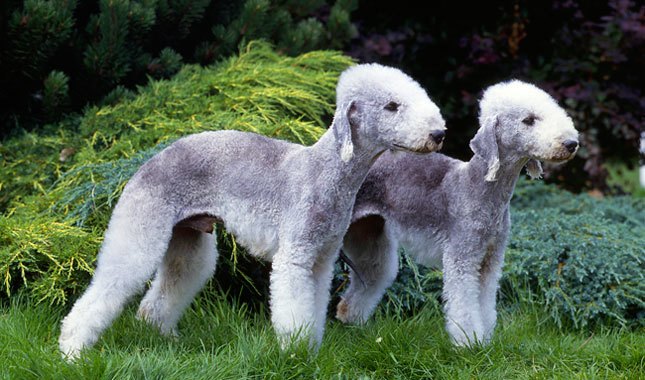Other names: Rothbury Terrier, Rodbery Terrier or Rothbury’s Lamb.
The Bedlington Terrier is a breed of small dog named after the mining town of Bedlington, Northumberland in North East England. Originally bred to hunt vermin the Bedlington Terrier has since been used in dog racing, numerous dog sports, as well as in conformation shows and as a companion dog. It is closely related to the Dandie Dinmont Terrier, Whippet and Otterhound.
It is described as a very versatile yet contradictory dog, being both good with children and “fit to kill any other dog of his weight”. They have powerful swimming skills, comparable to those of water dogs such as the Newfoundland, and are noted for being very quick and having high endurance. Bedlingtons are noted for their similarity in appearance to lambs. The dogs have blue, liver or sandy colouration, all three of which may have tan points. Their fur forms a distinctive top knot on the dog’s head. It is nonshedding and with minimal odour but needs weekly grooming to remove dead hair.
Originally known as the Rothbury or Rodbury Terrier, the name Bedlington Terrier was not applied to the breed until 1825, but some dogs have pedigrees that can be traced back as far as 1782. The first dog show with a class for Bedlington Terriers was held in 1870 at Bedlington. Bedlington Terriers shown at early shows were frequently dyed to improve the look of their fur. In 1948, a Bedlington Terrier known as Rock Ridge Night Rocket won best in the show at the Westminster Kennel Club Dog Show.
History

Bred in the village of Bedlington in Northumberland, the Bedlington Terrier has been described as “the favourite companion of the northern miners”. They were originally known as Rodbury Terriers, Rothbury Terriers, or “Rothbury’s Lambs” because the Lord of Rothbury had taken a particular liking to the dogs. Before this, they were known as “gypsy dogs”, as the Romani people—called ‘Gypsies’ in those days—and poachers used them to hunt. The first mention of the Bedlington terrier, or as it was then known, the Rothbury or Rodbury Terrier, was in 1825, most likely in The Life of James Allen, but some dogs’ pedigrees have been traced as far back as 1782. James’ father, William, was much in demand as an otter hunter, and he kept Bedlington Terriers to help him hunt. They were also valued by their owners as rabbit coursing dogs and racing dogs until the Whippet became more popular as a racing dog and a courser.
The Bedlington Terrier name was first given to a dog named Young Piper, which was owned by a man named Joseph Ainsley. Ainsley’s Piper has been called “the best of his race” and “had a reputation for great pluck and courage”. Piper began working with badgers at eight months old and carried on hunting other animals generally regarded as vermin until he was blind. Piper is also known for saving a child from a pig, keeping the animal at bay until help arrived. Piper died at fifteen.

The first shows that had a class for the Bedlington Terrier were held in 1870 at Bedlington. The following year, there was a Bedlington Terrier class at a show held at Crystal Palace, where a red dog named Miner took first prize. Miner also won a show held at Birmingham. The Bedlington Terrier Club was established in 1875. Many dogs in early shows were clipped and dyed to bring them closer to the breed standard and improve their chances of winning.
It is unknown if the judges of the time were aware of this practice, or if they cared. The practice of trimming was eventually accepted by The Kennel Club, under the pretence that the trimming was being done to “smarten a dog to show his shape and general contour.”
Bedlington Terriers are closely related to the Dandie Dinmont Terrier. The Earl of Antrim once exhibited two terriers from the same litter, and one won shows as a Dandie Dinmont, while the other won shows as a Bedlington. Bedlington Terriers are also related to the Kerry Blue Terrier and the Soft Coated Wheaten Terrier. The shape of its back suggests that it may relate to the Whippet and it may also be related to the otterhound. Bedlington Terriers have been crossed with Whippets to produce a Lurcher with “extra guts, pep, [and] fire.”
In 1948, Ch. Rock Ridge Night Rocket took best in the show at the Westminster Kennel Club Dog Show and was subsequently featured in LIFE magazine. One of his descendants, Ch. Femars’ Cable Car, was featured on the cover of Sports Illustrated in the February 8, 1960 edition.
